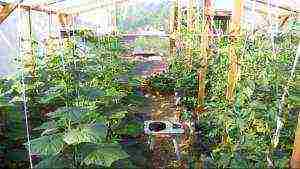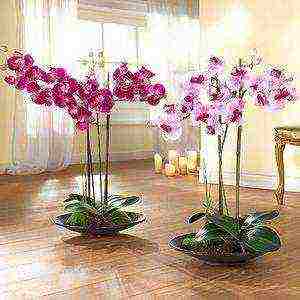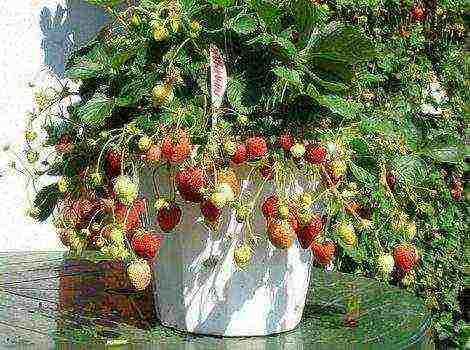Content
- 1 Delicious Edible Xylotrophs
- 2 Inedible but very beneficial xylotrophs
- 3 Edible mushrooms in the trees
- 4 Poisonous mushrooms in the trees
- 5 How to get rid of a tinder fungus on a tree (video)
- 6 Medicinal varieties of mushrooms on trees
- 7 How does fungal infection of trees occur?
- 8 Growing mushrooms (video)
- 9 How to deal with parasitic fungi
- 10 Conclusion
 Surely many of us have seen such a picture more than once: interesting growths of a bizarre shape grow on stumps, trunks and branches of trees, or mushroom bodies with legs and caps that are quite familiar to everyone. These are xylotrophs - a separate group of woody fungi that grow on tree species and receive food from there.
Surely many of us have seen such a picture more than once: interesting growths of a bizarre shape grow on stumps, trunks and branches of trees, or mushroom bodies with legs and caps that are quite familiar to everyone. These are xylotrophs - a separate group of woody fungi that grow on tree species and receive food from there.
By their nature, they are parasites and the appearance of such fungi on forest or garden crops means that the latter will die sooner or later. Spores penetrate into the wood through the slightest crack in the trunk, settle there and begin to actively multiply. Xylotrophs secrete special enzymes that break down wood polysaccharides, including cellulose, and thus mycelium feeds, taking nutrients from the tree. Due to the high concentration of carbon dioxide inside the wood, formed during the development of mycelium, the growth processes of woody fungi have a high speed.
Some species prefer to settle on dead trees, while others prefer exclusively living wood, and there are also such mushrooms for which this does not really matter. Take, for example, honey agarics - they are able to develop on any species, regardless of whether the tree is dead or not.
Most woody mushrooms have a wide, large cap and a short stem, or none at all, and the flesh has a tough structure. Some specimens are almost impossible to separate from the owner, so many people think that xylotrophs have no place in the kitchen. Indeed, inedible species of woody mushrooms prevail in their numbers, however, there are also mushrooms with good gastronomic characteristics among them.
Delicious Edible Xylotrophs
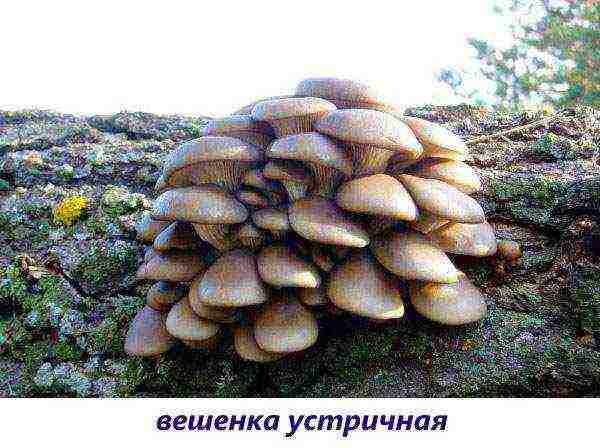 One of the most famous edible woody mushrooms is everyone's favorite oyster mushrooms. Under natural conditions, their mass accumulation can be seen in the Crimean deciduous forests, but oyster mushrooms are also successfully grown in artificial conditions on a special substrate. They grow in large families, the weight of one can exceed 3 kg. One of the most delicious and uncomplicated mushrooms to grow is oyster mushroom or oyster mushroom. It grows in large, multi-tiered and dense "nests", large caps up to 25 cm in diameter have the shape of a funnel and tucked edges. As for the color, they are most often light ash, although there are other color variations, from yellowish to dark gray. Under the cap there are rare, wide and white plates, which turn yellow in old mushrooms. The short stem is almost invisible. The pulp has a pleasant smell, white, dense structure.
One of the most famous edible woody mushrooms is everyone's favorite oyster mushrooms. Under natural conditions, their mass accumulation can be seen in the Crimean deciduous forests, but oyster mushrooms are also successfully grown in artificial conditions on a special substrate. They grow in large families, the weight of one can exceed 3 kg. One of the most delicious and uncomplicated mushrooms to grow is oyster mushroom or oyster mushroom. It grows in large, multi-tiered and dense "nests", large caps up to 25 cm in diameter have the shape of a funnel and tucked edges. As for the color, they are most often light ash, although there are other color variations, from yellowish to dark gray. Under the cap there are rare, wide and white plates, which turn yellow in old mushrooms. The short stem is almost invisible. The pulp has a pleasant smell, white, dense structure.
Oyster mushrooms can live on almost all deciduous trees, dead or weakened. The only exception is oak.
In addition to oyster mushrooms, edible tree mushrooms include:
- Winter mushroom (aka winter mushroom, velvety-legged colibia, enokitake). A small cap with a diameter of up to 10 cm is convex, colored yellow-brown. The stem is thin, tubular, brown, with a reddish tint in the upper part. The pulp is fragile, yellow, smells good, tasty. You can even eat old mushrooms, but without legs.
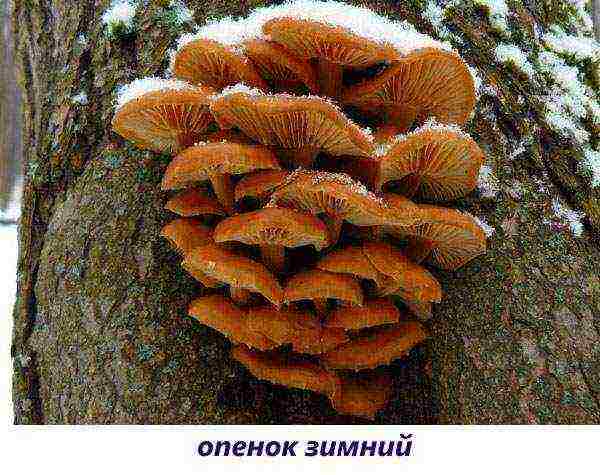
- Shiitake (aka the imperial mushroom, edible lentinula or Japanese forest mushroom).The mushroom is similar in shape to a meadow champignon: an umbrella-shaped brown cap with light plates and dry scaly skin grows on a fibrous stem. The pulp is light, fleshy, with a light peppercorn. They are widely used in Chinese medicine due to not only their high culinary, but also their medicinal properties.
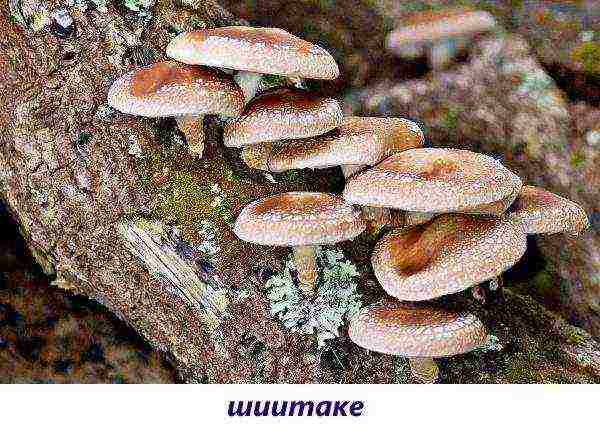
- Muer (aka black Chinese mushroom, auricular auricular or Judas ear). Prefers dead alder trees, in nature it grows mainly in China, but in our country it is found in the East. The fruiting body is thin, auricle-shaped, brown in color. The pulp is tender, jelly-like and silky, slightly crunchy, but becomes rough with age. Healing.
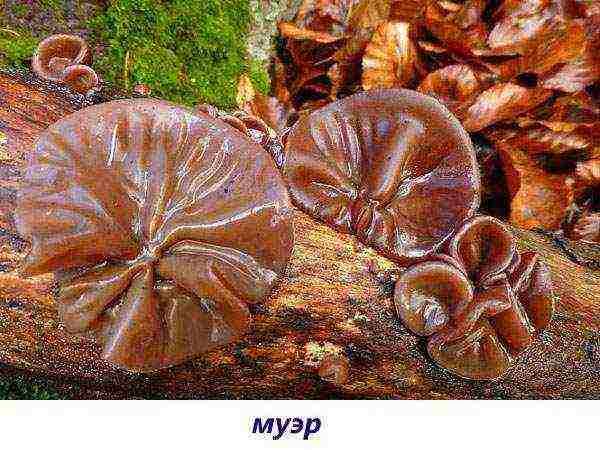
- Tinder fungus sulfur-yellow (aka chicken mushroom or witch's sulfur). It grows on weakened living deciduous trees in the form of multi-layered growths of yellow-orange color. Young pulp is very tender, juicy and tasty, old pulp is tough, dry and sour.
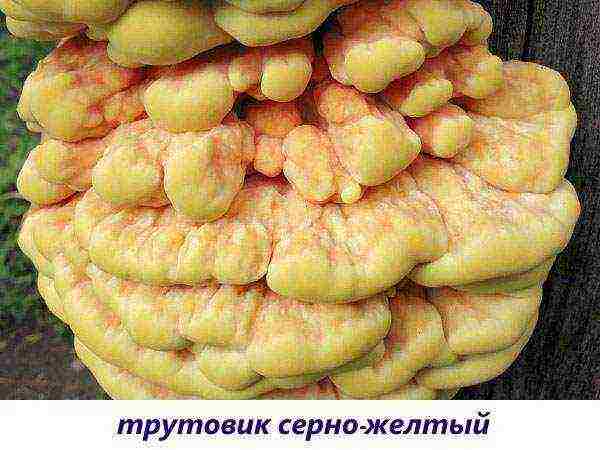
- Curly griffin (aka ram mushroom, leafy tinder fungus or maitake). It grows mainly on stumps of broad-leaved species. The fruiting body consists of many legs, smoothly turning into leaf-shaped caps with wavy edges, painted gray-green-brown with a darker center. The pulp smells like nuts, light and fragile. Old mushrooms are dark and tough.
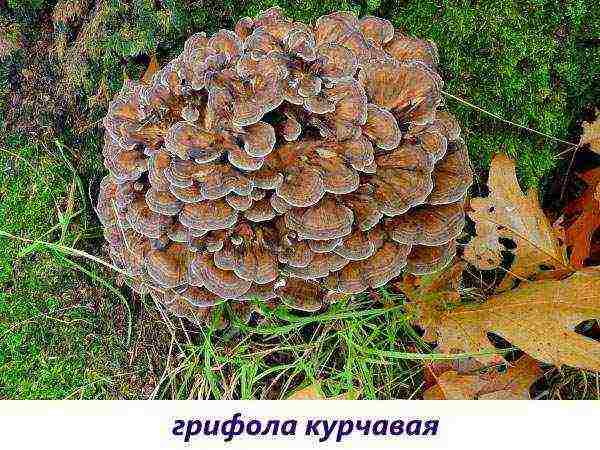
Among the species of woody fungi growing in the form of an outgrowth, young fruit bodies are the most delicious.
Inedible but very beneficial xylotrophs
As already mentioned, most woody mushrooms have a tough pulp, which is not at all pleasant to eat, and in some cases it is simply impossible, because it is so hard. At the same time, among them there are very valuable specimens from a medical point of view. On their basis, medicinal products are made that help fight many diseases, including such as oncology.
Some of the most useful woody inedible mushrooms are:
- Chaga larch birch. The fruit body is hoof-shaped, rough, cracked. The skin is off-white, darkens with age. It is a long-liver, a parasite on a tree for up to 20 years, the weight of one mushroom reaches 3 kg. Chaga pulp is yellowish. Most of the nutrients are found in young mushrooms growing on living trees.

- Lacquered polypore (aka Reishi). Grows on stumps and diseased deciduous trees. It has a small but very dense leg attached to the side of a very beautiful egg-shaped hat. The surface of the lacquered tinder fungus is shiny and wavy. Rings of a darker shade than the main color go along the hat. The color can be different: orange, red and even yellow-black. The pulp is tasteless and odorless at first, spongy, but quickly becomes woody.
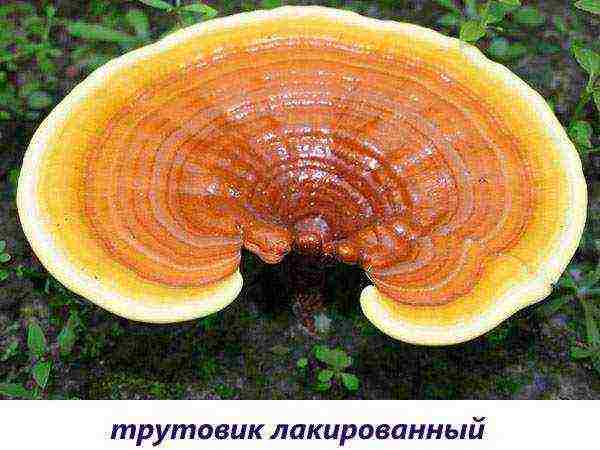
Summing up, we can say that although tree fungi are parasites that destroy trees and cause great harm to gardeners, nevertheless, some of these specimens are also useful, both in gastronomic terms and in medicine.
Video about growing edible tree mushrooms
A mushroom on a tree is common. However, organisms that grow on stumps and wood have different morphological properties. Some of them, despite the fact that they parasitize on a tree, are nevertheless taken quite calmly because of their symbiosis with a tree. But there are many varieties that are inedible.
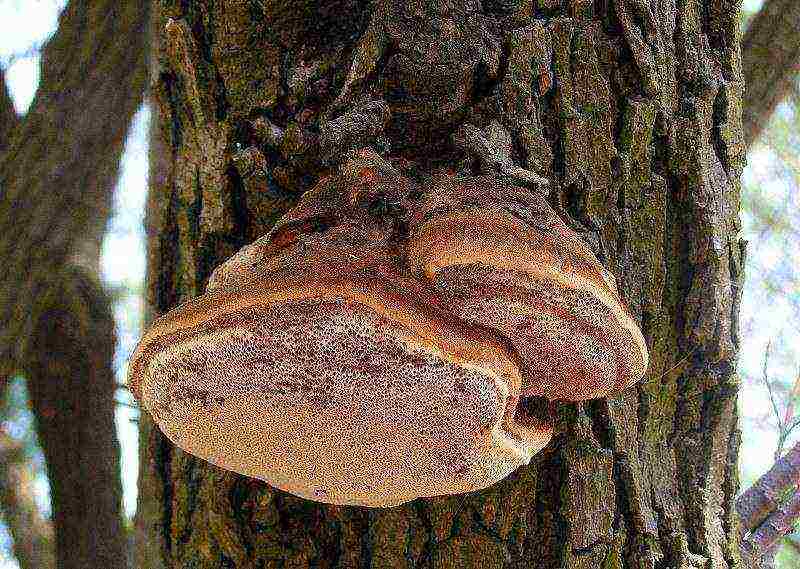 Mushroom on a tree is common
Mushroom on a tree is common
Edible mushrooms in the trees
Edible mushrooms often grow on trees, but there are not many varieties of them. Many of them are well known to mushroom pickers, as they have a pleasant taste and are nutritious. There are such edible mushrooms growing on trees:
- Curly griffin. It has fibrous flesh. Has a whitish shade and a pleasant persistent aroma. The cap is very bushy and thick, there are pseudo caps, which are intergrowths.The leg is clearly defined, has a light color.
- Chicken mushroom. It may also be called sulfur-yellow tinder fungus. The pulp is firm and firm. She is very fat. The young mushroom is very juicy. The cap has a teardrop shape. Has a yellow and orange tint. The leg is also yellowish, it is poorly expressed. Sometimes it comes out to grow such a fungus with your own hands.
- Oyster mushroom. The pulp is whitish. It is very fleshy and firm, but does not have a pronounced taste or smell. The cap is funnel-shaped or horn-shaped. It has a whitish-gray color. There are plates on the leg. With your own hands, you can grow such a mushroom at home using wood and hemp.
- Scaly tinder fungus. This is another 1 mushroom that grows on trees. The pulp has a pleasant smell. It is juicy but dense. The leg is short, has brownish scales. The cap also has such scales, but it itself is yellowish and leathery. You can also eat such a tinder fungus.
- Cellular polyporus. The cap of this mushroom has an oval or semicircular shape. It is covered with scales. Differs in yellow-red colors. The leg is short, located as if on the side. It is white and smooth. Polyporus can be grown by hand, but it is not easy to do. The pulp is white. It is harsh, does not differ in expressive taste, and its smell is barely discernible.
- Winter mushroom. You can also grow it yourself. The pulp has a delicate taste and light mushroom aroma. Differs in white. The hat is slippery and bulging. It has a brown tint, and is even darker in the center. The leg is velvety and hairy to the touch. It also has a brown color.
 Edible mushrooms often grow on trees, but there are not many varieties of them.
Edible mushrooms often grow on trees, but there are not many varieties of them.
Poisonous mushrooms in the trees
Mushrooms on trees can also parasitize. Moreover, this group of organisms is more numerous than those that are edible. It is not recommended to take them with your own hands, and even more so to use them, since they can harm human health. In addition, the fungus parasitizing on the tree is also dangerous for him, since there is no symbiosis between them, and this is more likely a disease. Despite this, some of them are actively used in medicine, as medicines are made from their pulp.
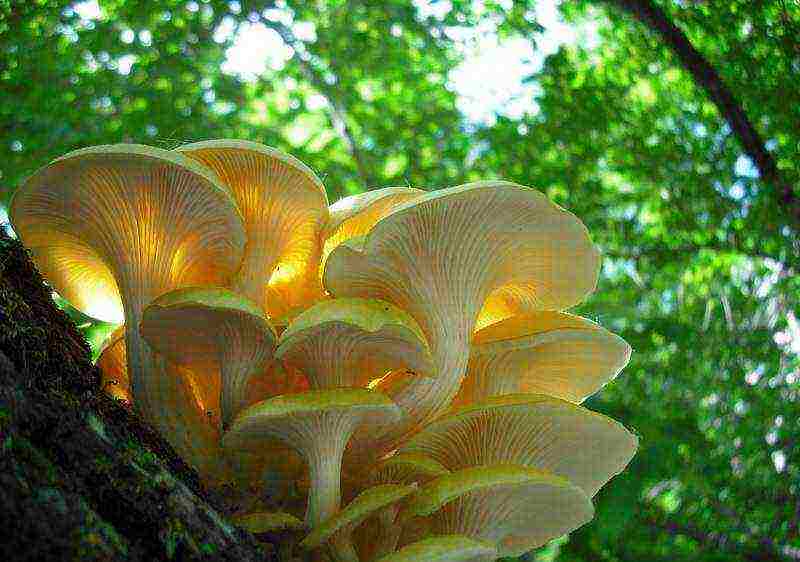
Here are the most common poisonous tree parasitic fungi:
- Fluffy trametes. It has a thin flesh. It has a leathery texture and a white tint. The cap has grooves, which are covered with grayish bristles at the top. The leg is the same color.
- The post is knitting. This is a mushroom that can grow directly from a tree. Its pulp is fleshy and juicy, but the taste is distinguished by bitter notes. The leg is white, short or absent altogether. The hat has a semicircular, shell-shaped, triangular or kidney-shaped shape. The surface is white.
- Piptoporus is oak. It can grow directly from trees. The hat has a fan-shaped or round shape. Differs in velvety. It often cracks. Has a brown tint. The leg has the same color, but is poorly expressed. The pulp is juicy, soft and white.
- Ischnoderm is resinous. She can often be seen next to trees. The hat is round. It sits tightly, and its base is creeping down. Has a reddish or brownish color. But the leg is lighter than her. Differs in smoothness. Medium in size. The pulp is fibrous and juicy. Has a light brownish or white tint.
- Ganoderma southern. It grows from a tree. She has practically no legs, and the hat is flat. Fit snugly, slightly arched. The wide part grows directly to the ground or wood, if it is on the trunk. The pulp has a dark red or chocolate hue. Very delicate and soft.
How to get rid of a tinder fungus on a tree (video)
Same
Medicinal varieties of mushrooms on trees
A mushroom that grows on a tree may have medicinal properties.There are several varieties, parts of which grow directly into the tree trunk. Many mushroom pickers actively collect such products and prepare medicines from them at home. Here are some common organisms that have medicinal properties:
- Lacquered tinder fungus. It can also be called a Reishi mushroom. It has a strong antitumor effect. In addition, it has immunomodulatory properties, stabilizes blood pressure, and improves fat metabolism. It is actively used in case of a breakdown.
- Tinder fungus beveled. It is also called chaga. Differs in antispasmodic action, and also fights bacteria. It also has reparative and diuretic properties. It can grow on a birch tree. Has a gastroprotective effect, accelerates the scarring of erosions and ulcers in the stomach and intestines. Able to maintain normal intestinal microflora. It normalizes the entire digestive tract.
- Larch sponge. This is another 1 mushroom growing on trees. It has a pronounced laxative effect. In addition, it stops bleeding, has a hypnotic and sedative effect. Helps reduce perspiration. Tinctures are made from deciduous sponges.

Mushrooms that grow on trees are useful as food for people with the following problems:
- increased blood cholesterol levels;
- the presence of anemia;
- high blood pressure;
- increased acidity of gastric juice;
- diabetes;
- obesity;
- weakened immunity.
By the way, medicinal mushrooms, like some edible ones, can also be grown independently, but this is a rather complicated process. So it is much easier to collect them in the forests.
How does fungal infection of trees occur?
As a rule, parasitic fungi attack the trunks of old trees, which gradually lose their ability to resist such organisms. Since they can no longer form a wound core that protects the plant from fungal spores. Mycotic organisms that destroy wood, spread not only to forest species, but also to an orchard and home gardens. Most often they affect oak, willow, linden, poplar, birch trunks. In addition, they can switch to walnut, pine, cedar, chestnut, maple trunk. Fir-trees and larch trees are much less likely to be sick, but the orchard will quickly suffer from spores.
Xylotrophic fungi are those that destroy wood. Infection occurs through damaged areas of the bark: broken off or cut off twigs, dry sides, wounds, frost holes, mechanical damage. The spores that dissipate in the air enter the bark and then germinate in the wood. Gradually, the mycelium spreads along the trunk, destroying it. Some species of xylotrophs prefer to settle on wood that has already been machined. For example, these are boards, posts, logs. In such places, tinder fungus, brownies, fence, pole, sleeper mushrooms grow. There are separate types of organisms that grow on root rot. They are also considered xylotrophs, but they are spread not only by spores, but also by contact with a healthy root system.

As a result, after infection, stem rot of a brown or red hue with destructive characteristics is formed. You can also see prismatic sound rot. Usually the parasite infects the nucleus. Some organisms are absorbed into the roots and from there they already suck nutrients from the plant through special threads. What mycotic organisms are parasitic, it is difficult to say at first glance. They can be bluish-black, orange, dark brown or light whitish. But in any case, their role is detrimental to the plant, as it gradually dies.But on the other hand, some parasitic species are forest orderlies, as they develop on diseased or old wood. In addition, they enrich the forest with nutrients.
Growing mushrooms (video)
How to deal with parasitic fungi
Various signs can indicate that a wooden trunk has rot inside. For example, this is the presence of a dry basin, fruiting bodies of mushrooms, bulges in the lower part of the trunk. The indicator of linear growth is also decreasing. However, there are times when there is rot, but outwardly this is not expressed in any way. To determine the presence of a mycotic disease, you can use special devices that allow you to study the tree from the inside, but there will be practically no harm to it.
For example, such is the resistograph. They need to drill a tree trunk that has become unhealthy. A special thin drill is used. At this time, sensors register various indicators, including the density of wood by its resistance to drilling. Then, with the help of a computer program, the internal state of the plant is determined.
You can also use another device - an arbot. This is a kind of tomograph. The principle of its operation is based on the fact that the speed at which the sound pulse of the equipment passes through the wood is measured.
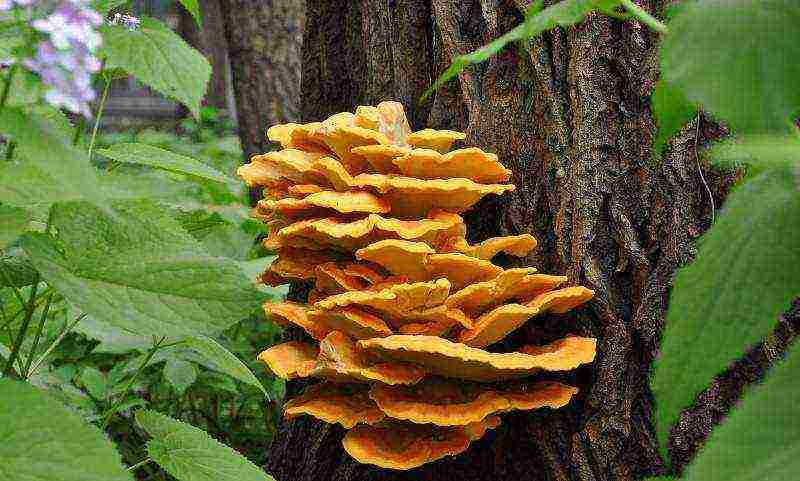
After diagnosis, a decision is made whether to remove or leave the plant. However, in addition, it is necessary to take into account the architectonics of the crown, the slope of the tree, the peculiarities of the tree species, soil, land, the presence of other objects next to it. Depending on how neglected the condition of the plant is, measures are taken to remove the tree if it is recognized as emergency. But sometimes it can be cured, or at least stopped the spread of rot. The hollow is treated by removing those parts that are affected by the mycelium. Then they need to be treated with fungicidal agents. Next, fittings are installed, which are closed with an insulating layer. Then the tree is sealed, and the seal itself is masked. All these works should be carried out only by a specialist.
But it is best to prevent mycelium damage. He is best opposed by healthy and strong plants, so it is necessary to clean up dry slopes in time, heal wounds, fill the hollows, remove dry and diseased branches. The cuts should be treated with a special sealant, varnish or paint. If there are diseased plants in the garden, then they must be removed in time.
Conclusion
Mushrooms in trees are quite common, and it is not surprising, because this is the best environment for them. Moreover, organisms can be both edible or medicinal, and poisonous. They parasitize on the trunks, branches, roots of the plant. To prevent this, it is necessary to carry out preventive measures in time in their gardens and vegetable gardens. However, some of these xylotrophic fungi are considered beneficial and can be harvested from forests.
Chapter 1. History of mushroom cultivation
The first cultivated mushrooms were champignons. Having originated in Italy, the mushroom culture spread in the 18th-19th centuries. in France, England, Germany, Sweden, Belgium, Holland. In the XVIII century. in St. Petersburg, a vegetable gardening establishment supplied the capital with artificially grown champignons. World production of champignons is growing steadily and amounts to 90 thousand tons per year. Mushrooms are grown on all continents, with particular success achieved in the countries of the East, China, Africa and South America.
Of the large number of types of mushrooms for industrial production, two-ring champignon and field champignon are used. Thanks to the use of proven technology, consistently high yields of 15-20 kg per 1 m2 per turn are obtained, with a number of revolutions per year equal to 6.
Factories for the production of mycelium have been established.This makes it possible to provide seed not only for Russian farms, but also for amateur mushroom growers.
Despite numerous attempts to breed porcini mushroom, it has not been possible to develop a technology for industrial production. This, apparently, is due to the mycorrhizal type of porcini fungus and the impossibility of providing the mycelium with nutrients that the fungus receives in union with the roots of trees.
In addition to champignons, saprophytic mushrooms that use decaying organic substances for their nutrition turned out to be promising for cultivation: rice straw mushroom, stropharik, purple ryadovka, gray talker, umbrella mushroom, dung beetle, morel.
Wood-destroying fungi, which in natural conditions live on wood, have received wide industrial cultivation. This group is the most unpretentious to the conditions of culture, easily adapts to artificial substrates, and bears fruit quickly. In Southeast Asia, Spitake is the most popular, as well as summer honey. The named species are grown on a plantation basis. Mushroom growers in China and Japan pay special attention to the winter mushroom.
Currently, thanks to research in artificial conditions, it has become possible to grow common oyster mushrooms. In nature, it grows on stumps, logs or on weakened living trees. The fungus inhabits only dead tissue, so it does not affect the growth of trees. Various plant wastes are suitable for growing oyster mushrooms: corn cobs and stalks, wheat straw, and their mixtures. To enrich the medium, malt sprouts, starch or soy flour, etc. are added, depending on the recipe. In India, oyster mushrooms are grown on rice straw.
In Japan, winter has one of the leading positions. Mushrooms are grown in containers on sawdust with various additives. Already at the beginning of the twentieth century. winter honey agaric was grown on tree trunks. The parts of the tree trunk with the grafted mycelium were half buried in the ground, but now this method is not widely used. Currently, in Japan, cryptomeria and pine sawdust is used for the cultivation of the winter fungus. They prefer old sawdust, as they are able to absorb moisture due to the decomposition process.
Summer mushroom cultivation is widespread in Germany, Czech Republic, Hungary. The mushroom is grown on waste wood. Among the wood-destroying edible mushrooms, spitake (shmitake) is especially popular. After champignon, it is the most widespread mushroom in the world. The genetic basis for the reproduction of Spitake and the development of the preparation of planting material based on sawdust allowed Japanese researchers to put the production of Spitake on a scientific basis.
Breeding mushrooms like cultivated plants is a mushroom picker's old dream. However, not all mushrooms are easy to cultivate yet. At present, out of a huge number of edible mushrooms, only a few, about 30 species, have been tested for cultivation in artificial conditions. Of these, only 8 species have been selected for industrial production, they grow well and bear fruit in culture. These are champignon, oyster mushroom, summer and winter honey mushrooms and some other mushrooms.
Next chapter>
